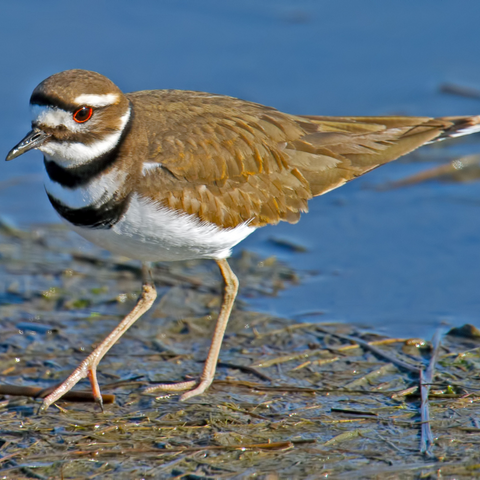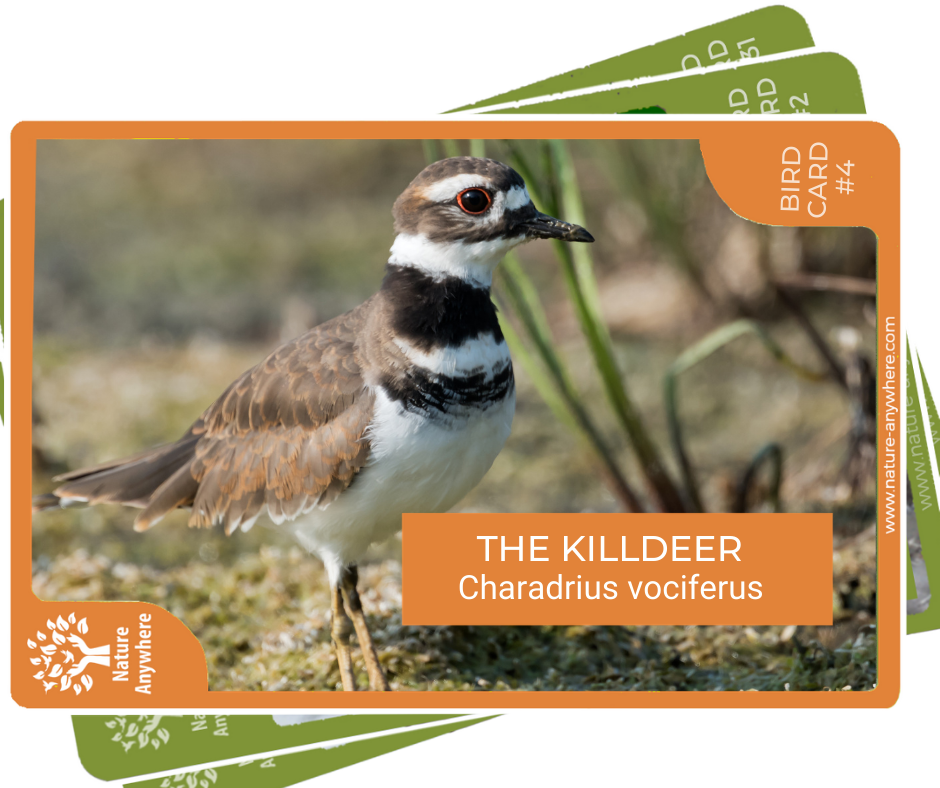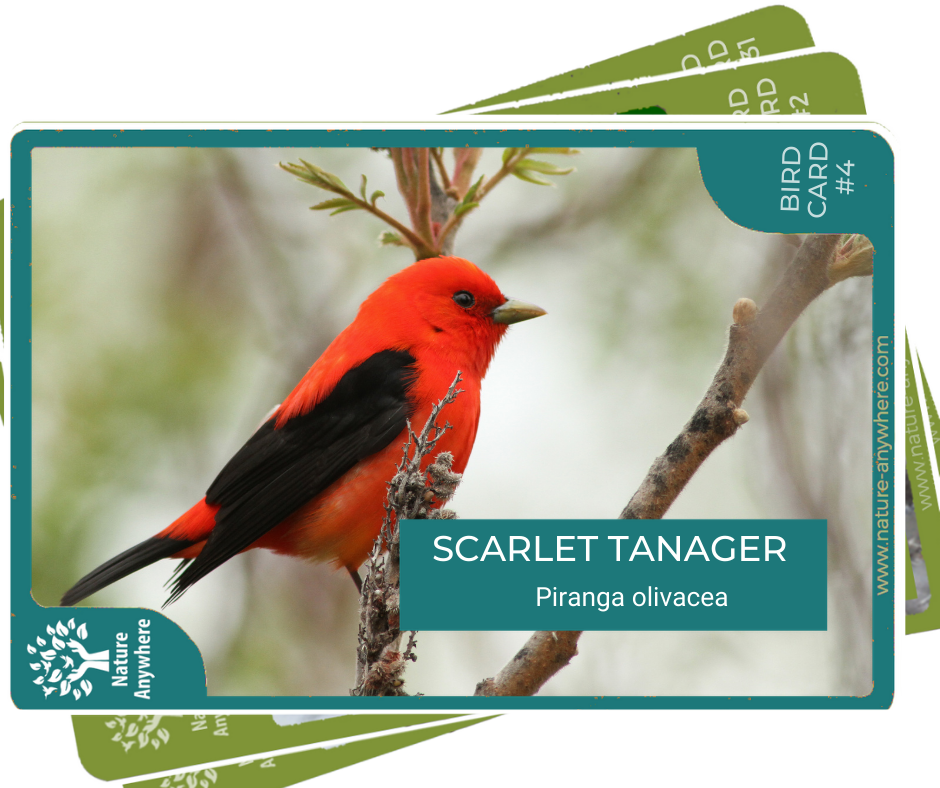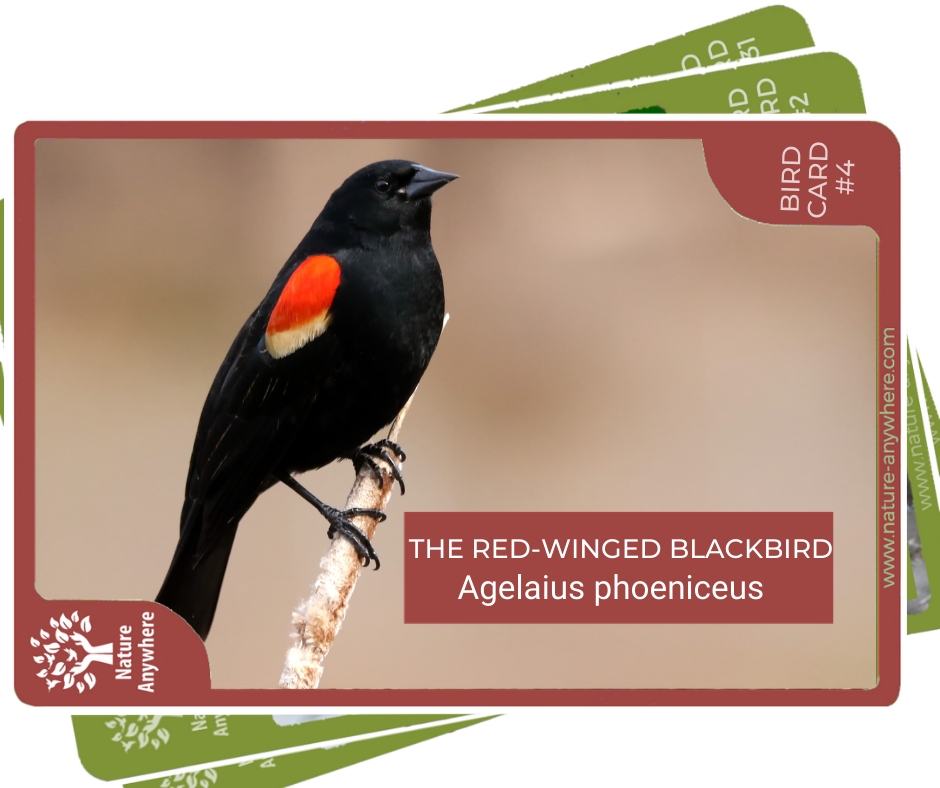
The Killdeer is the largest and best known of the "ringed" plovers. Although classified as a shore bird, these conspicuous, graceful birds are often found in areas far from water in open habitats across most of North America - from golf courses to lawns and parking lots.
Its scientific name Vociferus is the Latin word for shouting or clamorous, as this flyer has a very loud shrill cry. Charabrius is from the group of plovers which are wading birds, i.e shore birds. And don’t worry, these plovers don’t kill deer! Their name was given onomatopoeically, as they sound like they are chirping (loudly) “kill-dee” - especially in mid-flight or courtship.
Killdeer are usually solitary or in pairs. Occasionally they can be seen in a loose flock during non-breeding periods. Killdeers breed throughout North America. They migrate only to escape the cold, and are one of the first of the songbirds to return in the spring. So if you see one - summer is around the corner.
They are super entertaining to watch, strutting along the ground in spurts - then stopping in a sudden way in order to see if they have startled any insects or earthworms to prey on.

When killdeers see an intruder, they have a habit of bobbing up and down as if they have hiccups. But the most famous fact about these flyers is their lying on the ground, acting as if they have a broken-wing to lure predators away from their nest. They drag a wing on the ground pretending to be immobile. When the predator is far enough from the birds nest, the adult bird will fly away. “Gotcha!”
Cows or horses however still step on their eggs. In these cases, killdeers use a different tactic: they fluff themselves up, splaying their tail over their head, and run toward the hoofed animal in order to make it change its path.
Killdeers are used to humans nearby, as they build their nests on our roofs and gardens. But still, they are often shy, seemingly running away rather than flying.
Despite living on dry land, they are actually excellent swimmers. Adults can swim through rough waters, and their babies in calmer streams.
The average lifespan of a killdeer is 3-5 years. The oldest recorded Killdeer was 10 years and 11 months old.
LOOKS

The killdeer is the largest of the ringed plovers and the only of its kind with a double breast band. An adult is about 7.9 - 11.0 inches, weighing between 2.5 and 4.3 oz. Their most recognizable trait is the two rings around their neck that look like necklaces. They have grayish-brown upperparts for better camouflaging and white underparts with rusty colored rumps. Around their eyes they have red rings. Their bills are long and pointy - to reach insects and other invertebrates. Their legs are flesh-colored. In flight, the Killdeer's long, slender wings have conspicuous white wing stripes.
Adults and juveniles look the same year round, except the juveniles have a single breast ring.
Both sexes have the same type of plumage, but the male is larger than the female. Sometimes the females have more brown on their faces than the males.
EATS
Killdeers are insectivores, feeding off invertebrates such as earthworms, snails, crayfish, grasshoppers, caterpillars, beetles, spiders, and mosquito or fly larvae and aquatic insect larvae. They can often be seen following the farmers' plow in hopes of discovering any unearthed worms or insect larvae.
But they can go bigger - they have been known to hunt frogs and eat dead minnows. Being a shorebird, they nibble crustaceans as well. They also eat berry plant parts and seeds left in agricultural lands.
SOUNDS
Killdeers are talkative and noisy, so much so that they often serve as an alarm call for other birds and animals in general. Their calls are shrill and high-pitched. Although not categorized as a song-bird, their characteristic calls, which sound like “kill-dee”, “kill-deeah-dee-dee” or kill-deer’’ - have got them their name.
BIRDFEEDER
Killdeers don’t visit bird feeders. To attract these lovelies to your garden, leave gravel depression in your backyard in a sheltered area where they can build a nest. If your backyard is large enough with wide grazed fields or lawns, you could find Killdeer foraging about on your grounds.
KILL-LOVE!
Further south, breeding for killdeers begins in March but if the birds are further North, like Canada, breeding can run into June.
Killdeer couples tend to stay together for one to two years.The male selects a nesting territory by making several depressions in the ground for the female to choose in a ritual called “scraping ceremony”. Right by the site he makes a few aerial displays and makes bowing moves while calling her in loud chirps to impress her.
When the female accepts the male, she approaches him, lowers her head, and takes his place. The male then stands with his body tilted slightly forward, tail raised and spread, while continuing to call rapidly.
The match will last for a few breeding seasons. Even if they stay together for another year, he will still display his courting show again the following year.
Though shore birds, their nesting sites are away from water. Golf courses, short grass prairies, even your driveway are popular areas.
The nest is built by both the male and the female (unlike many other species!) and is actually completed after the eggs are laid. The female lays her eggs in a slight depression in the ground, lined with pebbles and grass with about 3-5 eggs covered with muddy looking splotches. Afterward the killdeers complete the nest. They can toss items over their shoulder right into the nest. In one nest in Oklahoma contained more than 1,500 pebbles!

Both the male and female incubate their eggs for about 24 - 28 days which is longer than most backyard birds. The newborns will stick around until their down dries up. They become rather independent soon after hatching.
FUN FACTS
~Stay hidden!
The killdeers often spend time on gravel and stones which is good camouflage for them, as their coloring is very similar.
~Collective noun
A group of killdeers are called "a ponderance of plovers" or a "season of killdeer."
WATCH: THE FAKE BROKEN-WING ACT!




2 comments
Judy Flaig
I have a couple in my driveway they have 4 eggs in a nest …. how do I keep them safe…
Agnes G. Anderson
I love the Killdeer…It not only a doting parent but it’s brilliant..A friend of mine had the Killdeer make a nest in her garden..It thought we were predators and showed us the broken wing farce ..very clever.We believed it at first Very good actors..Also the verbal skills …Very entertaining….Absolutely adorable…Love them..Fun to watch from afar..Do Not get too close to the nest…If you annoy them the parents can leave the eggs unhatched!!!
Leave a comment
All comments are moderated before being published.
This site is protected by hCaptcha and the hCaptcha Privacy Policy and Terms of Service apply.